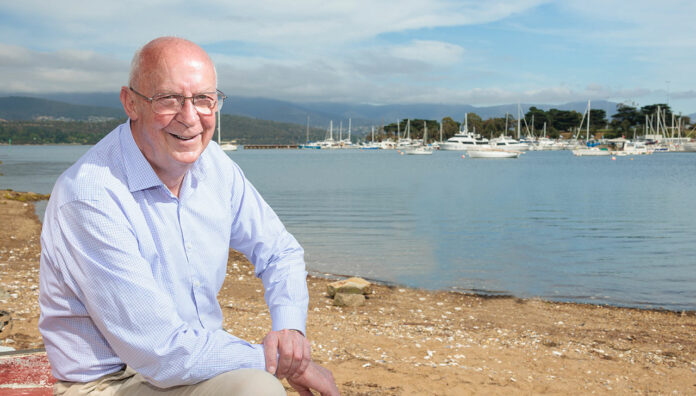When the Tasmanian government called for immunisers to staff its COVID-19 vaccination clinics, community pharmacist Robert Beaumont MPS from Amcal Pharmacy Lindisfarne was eager to put his qualifications as a pharmacist immuniser to good use.
What led you to pharmacy?
Pharmacy has always been my life. My father was a pharmacist who owned his own business and I was always in and out of the pharmacy. It was a natural progression.
I did my internship in 1974 and have experienced many aspects of the profession since then, including working as a compliance pharmacist for Medicare, roles in public and private hospitals and owning businesses myself.
Why did you become a pharmacist immuniser?
I could see it was an emerging area. All the new graduates were coming out of university with that skill and I thought if I wanted to keep up, I should go down that path. Now I use this skill in a state-run COVID-19 vaccination clinic and in the community pharmacy where I work.
What attracted you to working in the state-run clinic?
I wanted to be part of the big rollout and do something that needed to be done. I saw it as a call to arms to stand up and help with the biggest public health intervention in recent memory.
It’s very rewarding. Recently, a mother brought in her 13-year-old daughter who is autistic. At first she was quite scared, but we calmed her down and eventually I was able to give her the vaccine.
‘At the moment, the most satisfying part of my role comes from being thanked by the people I vaccinate.’
We made sure the same staff would be on when it was time for her second dose. When she did come back, she was quite happy for me to vaccinate her. That was great. You know you’ve done the right thing when a patient comes back and wants to see you again.
With no immunisation for children under 10 here, the main immunisation now is for boosters so most customers have few questions and just want the job done ASAP. There are some people who can’t look and are scared. There have been two people I have not been able to vaccinate, both of whom had extreme needle phobias.
How do you deal with vaccine hesitancy?
I’ve had people turning up who are anti-vax. In that situation, I take the approach that I’m just there to vaccinate – it’s not my job to judge or to be critical. I have also seen pharmacists hesitate to become immunisers. I think this comes from not being confident in your own abilities. I’ve found this as well and my advice is to just do it. Everything will fall into place with continued learning, by watching and listening to experienced vaccinators.
What are the biggest changes you’ve seen in the profession?
It used to be that a pharmacy was owned by a sole practitioner who worked in the business, maybe with one other pharmacist. Now we’ve got multi-pharmacist pharmacies that can offer a variety of services such as MedsChecks, sleep apnoea services – our role has really blossomed.
Now we’ve got to get recognition for what we do. In the past, we did things and no one paid us – we offered free advice. We’ve got to be recognised and rewarded for that in some way. It is happening but it has to progress further.
What do you enjoy most about being a pharmacist?
At the moment, the most satisfying part of my role comes from being thanked by the people I vaccinate. That gratification is a good reward. Over my career it has been talking to people and trying to help them and solve their problems.
Where do you see yourself in 10 years?
I am currently approaching 71 years of age, so I should be well and good retired.
A day in the life of Robert Beaumont MPS, a pharmacist immuniser in a Tasmanian COVID-19 vaccination clinic.8.00 am – Prepare for the day Draw up vaccines (Pfizer only) with two immunisers double-checking all expiry dates and batch numbers. This can take 1–2 hours. Drawn-up vaccines are placed into a ‘lunch box’ with the empty vial and a label with all details (batch, expiry, date, time, immuniser name, and vial number for the day). All details are entered onto a daily running sheet. 9.00 am – Get started Begin vaccinations – and later take a 10-minute break. Some patients can be challenging and only come in because they have to be vaccinated in order to keep working. Others are pleased to be jabbed. These are the ups and downs. 12.00 pm – Lunchtime! Clinic closes for 1 hour lunch (lunch break is 30 minutes) with drawing-up for the other half hour. 1.00 pm – Back at it Recommence vaccinating with a 10-minute break later. 5.00 pm – Not quite over Clinic closes to customers. Immunisers clean, restock the booths and help with reconciliation of dose numbers. 5.30 pm – Another day done Time to pack up and head home. I spend my time outside of the pharmacy with my family, attending to things around the house and relaxing. I also enjoy sailing and working with timber. |
Explore new paths at www.psa.org.au/careerpathways




 ‘We’re increasingly seeing incidents where alert fatigue has been identified as a contributing factor. It’s not that there wasn’t an alert in place, but that it was lost among the other alerts the clinician saw,’ Prof Baysari says.
‘We’re increasingly seeing incidents where alert fatigue has been identified as a contributing factor. It’s not that there wasn’t an alert in place, but that it was lost among the other alerts the clinician saw,’ Prof Baysari says.


 Beyond the arrhythmia, AF often signals broader pathological processes that impair cardiac function and reduce quality of life and life expectancy.5 Many of these conditions are closely linked to social determinants of health, disproportionately affecting populations with socioeconomic disadvantage. Effective AF management requires addressing both the arrhythmia and its underlying contributors.4
Beyond the arrhythmia, AF often signals broader pathological processes that impair cardiac function and reduce quality of life and life expectancy.5 Many of these conditions are closely linked to social determinants of health, disproportionately affecting populations with socioeconomic disadvantage. Effective AF management requires addressing both the arrhythmia and its underlying contributors.4  C – Comorbidity and risk factor management
C – Comorbidity and risk factor management Warfarin
Warfarin







